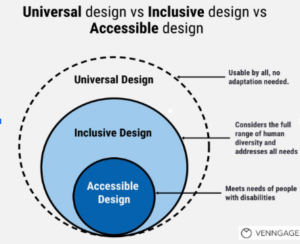Design choices have a significant impact on how people interact with the world. These choices can either create barriers or opportunities for different groups. Inclusive and universal design principles aim to reduce exclusionary practices by promoting the creation of accessible, diverse, and user-focused environments. By prioritizing inclusivity and universality, businesses and designers can ensure that their digital products and services meet the needs of diverse user groups, which ultimately benefits everyone.
In this blog, we will delve into the significance of inclusive and universal design, their differences, and distinctions to create digital spaces that embrace diversity and cater to the needs of every individual, including individuals with disability.
 Photo Credit: Venngage
Photo Credit: Venngage
What Is Inclusive Design?
Inclusive design is a methodology focused on creating products, services, and environments that are accessible and usable by the widest range of individuals, regardless of their abilities or disabilities. It goes beyond accommodating specific needs and considers the full spectrum of human diversity, including factors such as age, gender, culture, and language. Inclusive design prioritizes accessibility and emphasizes the importance of incorporating diverse perspectives throughout the design process. By actively involving individuals with different backgrounds and abilities, accessibility and inclusive design aim to minimize barriers and promote equitable access for all users. Ultimately, the goal of inclusive design is to create user-focused environments that enhance usability, inclusivity, and overall user satisfaction.What Is Universal Design?
Universal design is a comprehensive approach that seeks to create products, environments, and systems that can be used by people of all abilities, ages, genders, and cultural backgrounds. The core principle of universal design is inclusivity, which means designing with diversity in mind. This approach recognizes the varying abilities, preferences, and characteristics of individuals, and seeks to create solutions that can be used by everyone to the greatest extent possible, without the need for adaptation or specialized design. To achieve this goal, universal design emphasizes flexibility, simplicity, and intuitive use. Products and environments are designed to be adaptable to a wide range of needs and preferences and to be easy to use and understand. The focus is on creating solutions that are accessible and usable by as many people as possible, not just a specific user group. Universal design principles prioritize the needs of individuals with disabilities, as they are often the most underserved when it comes to design. However, the goal is not to create separate solutions for specific user groups, but to create solutions that can be used by everyone. This means that universal design goes beyond accessibility and also takes into account the needs and preferences of diverse user groups, such as children, the elderly, and individuals from different cultural backgrounds. Photo Credit: Venngage
Photo Credit: Venngage
Key Differences
Inclusive and universal designs are two approaches aimed at creating environments that are accessible to everyone. Inclusive design focuses on customizing solutions to meet the diverse needs of users, whereas universal design aims to create inherently accessible products and spaces that can be used by the broadest range of users from the outset. Some notable differences between the two approaches are:| Criteria | Universal Design | Inclusive Design |
| Focus | Creating products, environments, and services that can be used by everyone without adaptation or specialized design | Creating inclusive products, environments, and services by removing barriers for marginalized groups |
| Goal | Ensuring maximum accessibility for everyone through an operational framework | Creating a user-friendly experience while also promoting a sense of inclusivity and mutual respect among everyone involved |
| Approach | Offering a solution that can cater to the needs of a diverse range of individuals, with a focus on developing features that can benefit the maximum number of people | Offering tailored solutions for diverse needs and abilities as opposed to a generic approach |
| Scope | Prioritizing a single solution that is adaptable to a degree | Exploring various solutions that can be customized or altered to meet diverse needs |
| User Experience | Achieving a consistent and simplified user experience is made possible through the use of standardized features and intuitive interfaces | Accommodating individual needs and preferences by actively involving diverse users by using customized design solutions |
Where Accessibility, Inclusivity, And Universality Meet
In a world that is increasingly reliant on technology, digital designs must be usable for all. With 15% of the global population living with a disability, accessibility remains of paramount importance. Inclusive and universal design are two strategies that can help achieve this. While inclusive design accommodates diverse experiences and reduces barriers based on culture, gender, age, ability, and more, universal design aims to make products usable for as many people as possible, regardless of differences in income, background, disability, or other factors. By incorporating features such as video captions, motion sensors, speakerphones, and text-to-speech capabilities, digital designs can serve as accessible products that benefit all users. Accessible digital designs are essential for the future, and by embracing inclusive and universal design principles, we can ensure that technology is usable and beneficial for all.Cultivating Accessibility And Inclusivity Through Design
The principles of inclusive and universal design are crucial in developing products that are accessible and centered on human needs. By implementing these approaches and implementing accessibility solutions such as Continual Engine, designers can ensure that digital experiences cater to diverse needs and abilities, encouraging inclusivity and participation for all users. Combining these strategies allows us to create a more inclusive world where everyone can engage meaningfully, irrespective of their background, abilities, or differences. To learn more about our scalable accessibility services, reach out to us at contact@continualengine.com or visit https://www.continualengine.com Interested In Learning More About Accessibility solutions? Stay in the know and be updated about the latest advancements and trends with Continual Engine!Get AI-Driven Accessibility Solutions
Empower your organization with scalable, cost-effective, and efficient tools for an inclusive user experience.